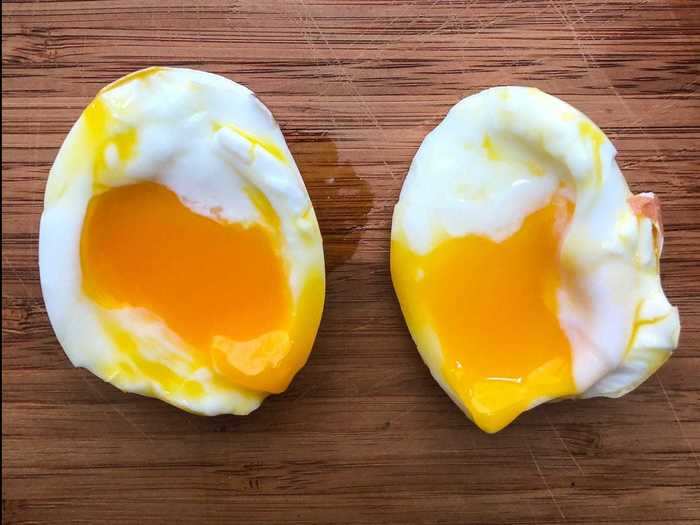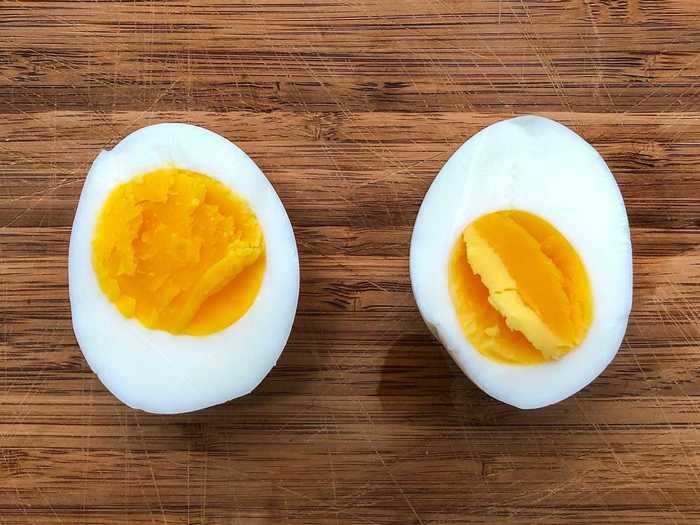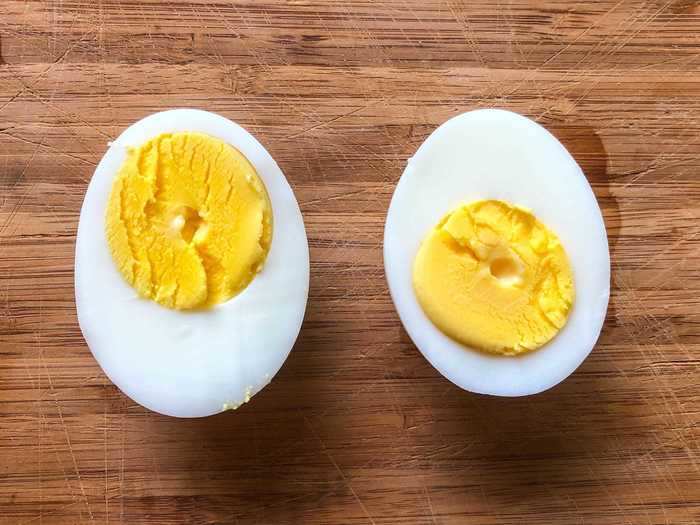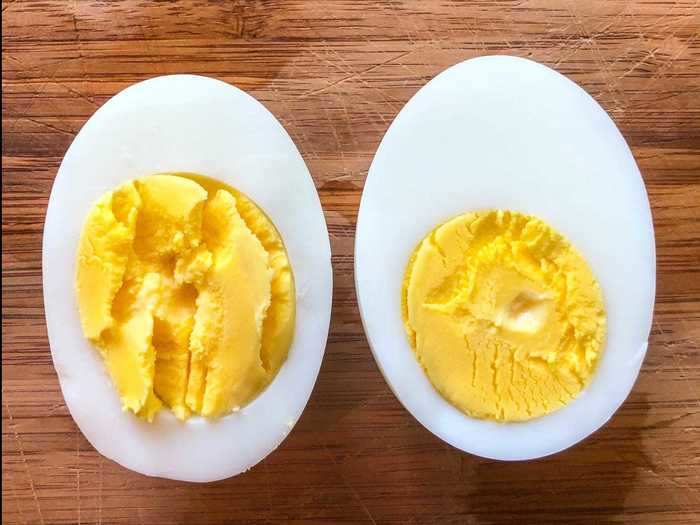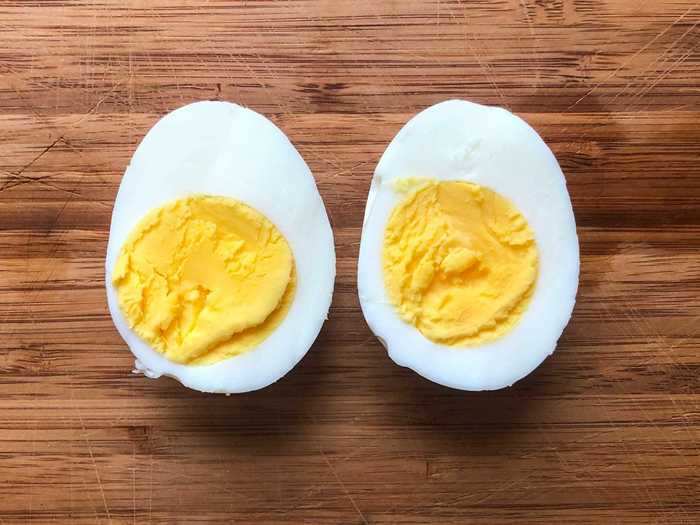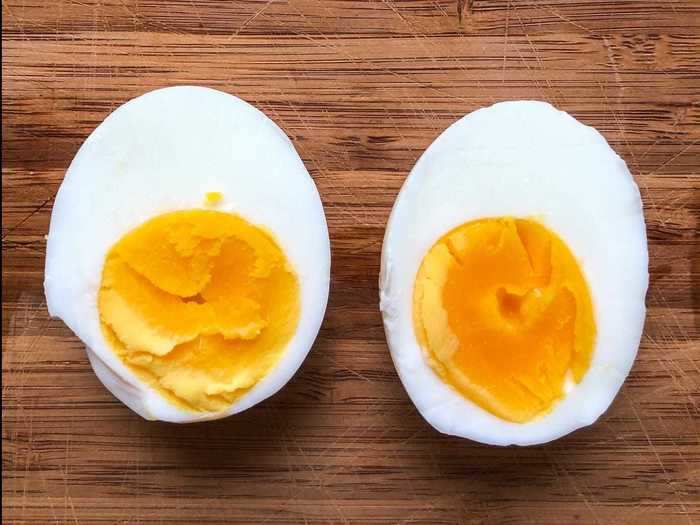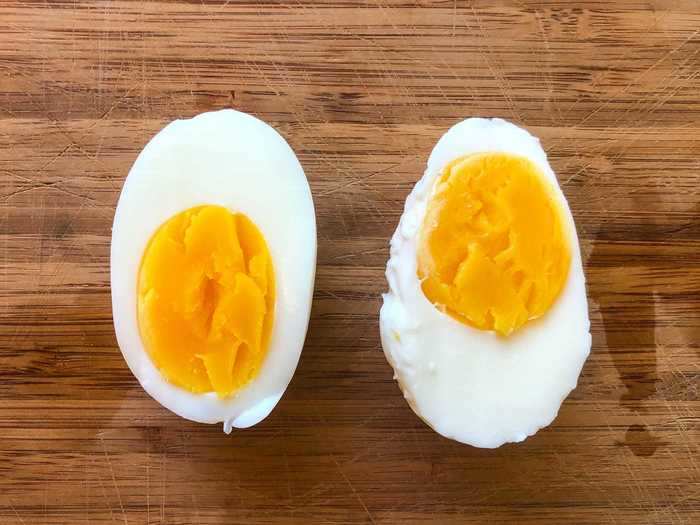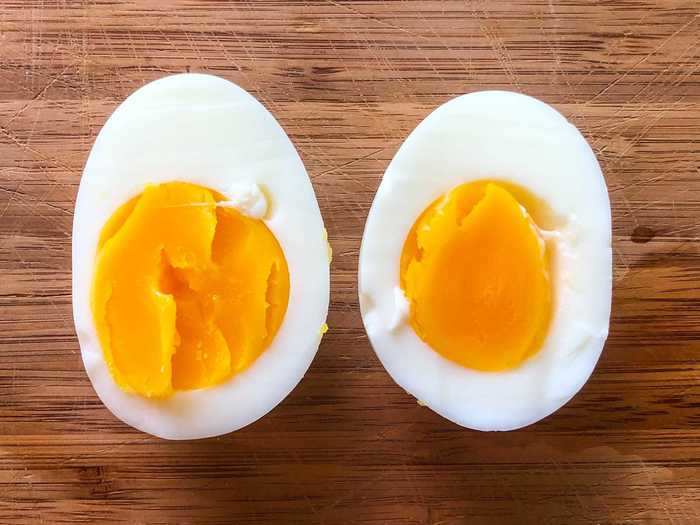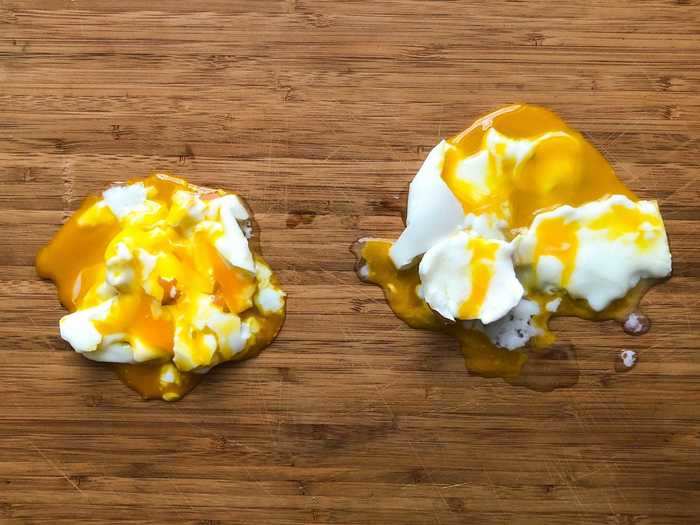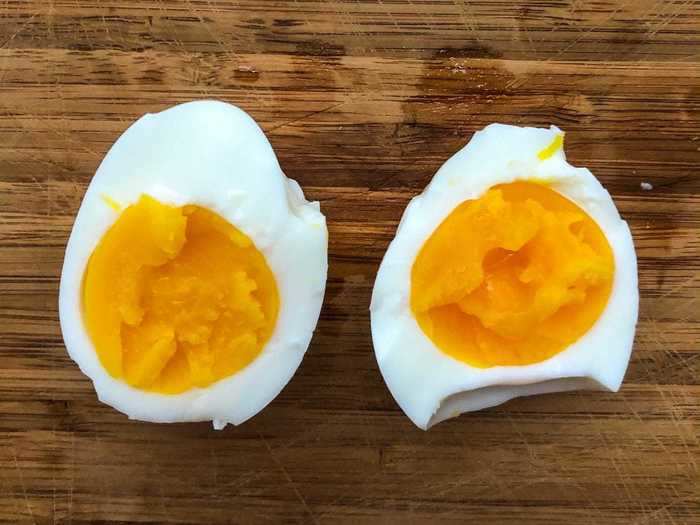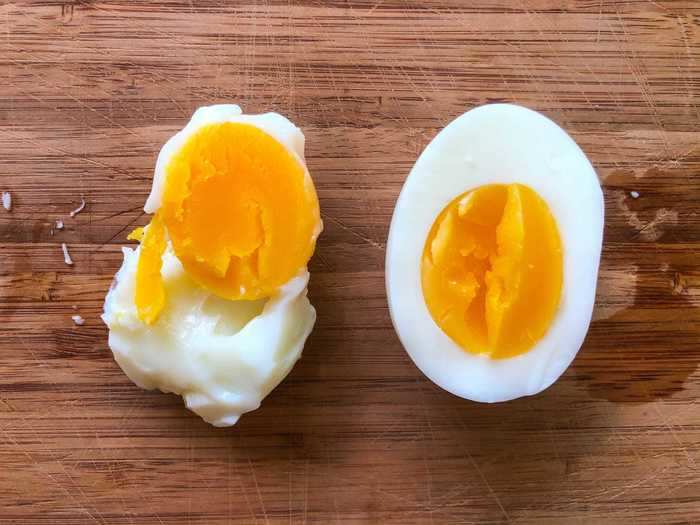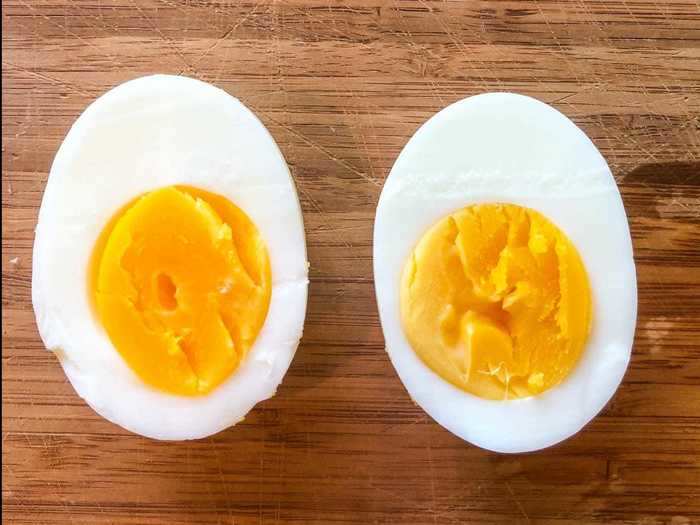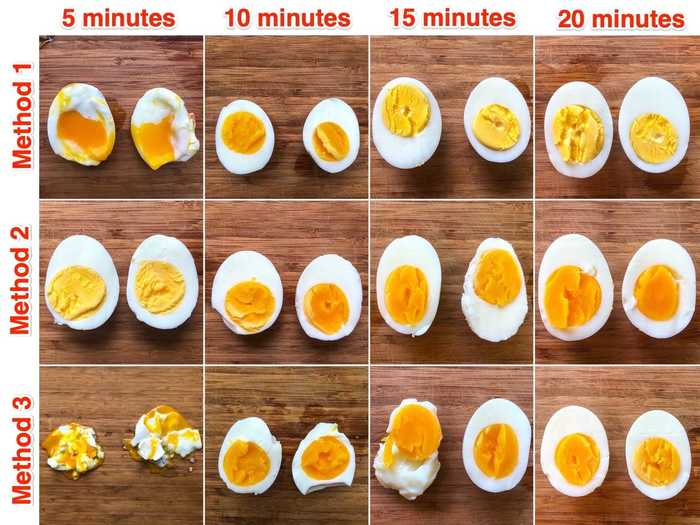Insider
- I made 24 hard-boiled eggs in two dozen ways to see how time and different cook methods can affect their texture, taste, and ease of peeling.
- Some people bring their water to a boil before dropping their eggs in the pot, while others start their eggs in cold water and then bring it to a boil, so I tried both methods.
- I compared the effects of using an ice bath — the purpose of which is to stop the egg from continuing to cook after it's removed from the water — to not using one.
- An ice bath is also supposed to make the egg easier to peel, but I didn't find that to be the case.
I make hard-boiled eggs quite often. They're a great ready-made snack, and a good way to use up eggs that might be nearing their expiration date.
My go-to method has always been to drop eggs into boiling water, reduce the heat to simmer, and let them sit for around 13 to 15 minutes, but there are so many different ways to make eggs. Doing some research, I found endless lists from different home cooks and celebrity chefs suggesting a myriad of methods.
To see how eggs would turn out when cooked in different ways, I set out to test three cooking methods at four different cook times.
For each method/time combination, I made two eggs, putting one in a 10-minute ice bath before peeling to see if it would make a difference. An ice bath stops the egg from continuing to cook after it's removed from the water, and is also meant to make peeling easier.
In each photo below, the egg on the left was peeled while warm, and the egg on the right was peeled after an ice bath. And it's worth noting that I used large eggs for this experiment, so the results might not look the same for you if you're using another size egg.
For the first method, I dropped the eggs in boiling water, reduced the heat, and let them simmer. After five minutes of simmering, the eggs were runny.
The whites on these were semi-cooked.
Rachel Askinasi/Insider
After researching different ways to cook an egg, I saw that placing it in a 10-minute ice bath was supposed to make the egg contract inside the shell, making it easier to peel. In this case, though, the ice bath didn't seem to make too much of a difference. Both eggs were difficult to peel and pieces of the shells clung to the whites for dear life.
The egg that was put in the ice bath was much runnier than its non-iced counterpart. That makes sense, though, since the ice water stops the cooking process.
In the case of the ice-submerged egg, the whites were runny, which isn't ideal. While they weren't completely cooked through, they were mostly solid in the egg that didn't receive an ice bath.
I couldn't fully bite into these as they were, well, mostly raw. But, if I let them sit out of the water and cook in their own heat just a few minutes longer, the white would have continued to cook leaving me with what would resemble a poached egg.
Using the same method and letting them cook for 10 minutes gave the yolks an unpleasant texture.
The yolks of these eggs were both unenjoyable.
Rachel Askinasi/Insider
The whites were perfectly cooked here and I was able to see the huge difference that just five more minutes in the pot can make.
Both yolks kept their bright-orange color for the most part, but some bits were starting to become more of a pale yellow.
When I bit into them I found the texture to be slightly gummy. I thought the consistency of the whites was great — solid but not rubbery.
Both eggs were easy to peel, regardless of the ice bath.
Simmering for a total of 15 minutes left me with delicious, hard-boiled eggs.
The egg yolks here both turned a pale yellow.
Rachel Askinasi/Insider
Both of these eggs were easy to peel; I didn't end up losing any of the whites in the process.
The yolks of both eggs were dry, but the one without the ice bath felt a little creamier in its texture.
I was nervous that I had overcooked the eggs, but there was no gray ring around the outside of the yolk; that's typically how you can tell if you've overboiled your egg. The whites were also fully cooked and didn't feel too rubbery.
While the yolk and white felt like one cohesive piece in the egg on the left (which didn't get an ice bath), the two components separated and fell apart easily after taking a bite of the egg on the right (which did get an ice bath).
I simmered the eggs one last time for 20 minutes, which didn't make much of a difference from 15 minutes.
I could barely tell the difference between these two eggs.
Rachel Askinasi/Insider
Again, both eggs were easy to peel and had the same color yolks.
The yolks were slightly more dry than the ones cooked for only 15 minutes, but the one without the ice bath stayed mushier in its consistency than the more solid iced egg. I was able to tell the difference when I slid my knife through each of them; the one in the ice bath was easier to cut.
In terms of mouthfeel, though, the two were nearly identical.
I think this cooking method and timing combination is perfect if you're looking to make egg salad or slice eggs for a sandwich.
For the next method, I started the eggs in a pot of cold water, brought it to a boil, covered the pot, and removed from the heat. Letting the eggs sit in the pot for five minutes after taking it off the heat cooked them rather thoroughly.
Both shells were difficult to remove.
Rachel Askinasi/Insider
In the process of peeling both of these eggs, I lost some of their whites.
After sitting in the hot water for just five minutes, the yolks were a beautiful pale yellow and the whites weren't runny at all.
While both were fully cooked, the egg that went into an ice bath came out of it with a firmer white. It also had less of an overall sulfur taste than the egg without the ice bath.
After 10 minutes of sitting in the pan, the egg that didn't have an ice bath had a silky smooth yolk while the other was firmer and more rubbery.
I would choose to skip the ice bath for this cooking method.
Rachel Askinasi/Insider
Unexpectedly, the egg in the ice bath was a lot harder to peel, while its uniced counterpart peeled quite easily.
In terms of the yolks, the egg on the left had a really silky consistency which was awesome. I think this method without the ice bath is great for an egg you just want to bite into as a snack.
The egg on the right, though, was firm inside and felt rubbery. It clumped together when I tried to take a bite.
The whites on both were cooked well, though.
And after 15 minutes of sitting in the pot, both eggs had that rubbery consistency.
I lost a lot of egg whites when I peeled the shell off the chilled egg.
Rachel Askinasi/Insider
After cooking for five more minutes, the egg that came out of the ice bath was much harder to peel. I ended up peeling off a lot of the white with the pieces of shell.
Both yolks, regardless of the ice bath, were weirdly solid and gumlike. They were a bright-orange color, which looks delicious, but I wouldn't eat these whole.
After a full 20 minutes, the yolks separated from the whites.
Both of these tasted better than they looked.
Rachel Askinasi/Insider
After cutting them both open, I thought they looked equally rubbery. But, the egg without an ice bath actually had a yolk with a velvety texture.
After the ice bath, the white and yolk seemed to have pulled away from each other. Even still, both whites were very soft and enjoyable.
Lastly, I tried starting the eggs in boiling water, turning off the heat right after I dropped them in, and let them sit covered. Sitting for just five minutes caused an egg explosion.
Yolks flooded my cutting board when I sliced into these eggs.
Rachel Askinasi/Insider
This was a total disaster. I was able to peel both eggs at first, but it turned out that only the very outside layers of the whites were cooked; everything else was completely raw.
Of course, I wasn't able to taste these, but I did learn that every minute counts when it comes to cooking eggs. At least, the next batches got better.
At 10 minutes total, this method yielded some decadent eggs.
Although they were tough to peel, these eggs were delicious.
Rachel Askinasi/Insider
Ten minutes was the sweet spot for me with this cooking method. Both yolks were super velvety, and tasted rich and decadent.
The whites were fully cooked, although I lost a good amount of them in the peeling process as they were stuck to the shell.
Both the eggs, regardless of an ice bath, tasted the same.
Letting the eggs sit in the water for 15 minutes made the yolks solid and rubbery.
I was surprised at how difficult to handle the uniced egg was here.
Rachel Askinasi/Insider
The egg that cooled on its own without an ice bath was nearly impossible to peel. Its white was semi-runny still and I lost almost all of it in the peeling process. The yolk was cooked through, but it was rubbery in texture.
The egg in the ice bath was easy to peel and the white was cooked well. Its yolk was somewhat velvety, but it was also kind of gummy and rubbery.
I wouldn't recommend using this cooking method for any reason.
After 20 minutes, both whites were cooked and the eggs were easy to peel.
I would choose to chill my eggs if I made this version again.
Rachel Askinasi/Insider
I was able to easily peel both of these eggs after they had cooked for 20 minutes.
When I got them out of their shells, I saw that the whites were cooked perfectly. Both yolks looked the same, but the one that had been in an ice bath was much creamier and the one without the ice bath was solid and chunky.
If I used this method again, I would definitely use the ice bath.
Every minute counts when you're boiling eggs.
All 24 eggs and how I made them.
Rachel Askinasi/Insider
After making two dozen eggs each in their own way, I found that the ice bath doesn't really make much of a difference.
I learned that it's not just the length of cook time that matters when it comes to hard-boiled eggs. It's the combination of cooking methods and timing that can yield drastically different results.
I was pleasantly surprised by the eggs I made when using the third cooking method at the 10-minute mark. I would definitely try making these again especially if I'm making a snack on the spot. In terms of making eggs for later, though, I'll likely stick to what I know and simmer for 13 minutes.
And if it goes wrong, don't beat yourself up. It's hard to cook a perfect egg, especially when the success of your finished product is hiding behind a shell. Ultimately, you won't know how it turned out until you crack it open.

